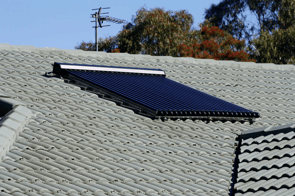For a while, solar hot water was the best choice for someone looking to get hot water with minimal carbon emissions and cost. Now, they’ve been eclipsed by advancements in heat pump technology – but that doesn’t mean solar hot water isn’t still an option you might consider.
Here, we run through the pros and cons of solar hot water systems, to give you an idea of if it might be right for you.
How solar hot water systems work
Before that though, let’s just take a moment to cover off how these systems work. Just like with gas and electric, there’s more than just one-size-fits-all – solar hot water splits into two types, close-coupled and pumped/split systems.
In a close-coupled system, you keep the tank on the roof. This is used for homes that don’t have a lot of space on the ground and need to reduce their system’s ground profile. These systems either use direct or indirect heating.
Direct heating will pass the cold water through the solar collectors on the roof. It heats up and, once it’s hot enough, the water passes into the storage tank. This draws more cold water through the collectors, which continues the cycle.
With indirect heating, the water is kept separate from the tank and treated with an anti-freeze agent. The sun still heats the water – but rather than directly feeding it into the tank, a heat exchanger is used to extract heat from the water. In areas where frost can be an issue, this is the system that’s used – water freezing in the tubes can cause serious damage.
For a pumped system (as opposed to close-coupled), the tank is kept on the ground. A powered pump then moves hot water from the collectors down to the tank. This does draw a bit of electricity, but it’s a fairly negligible amount.
The sun doesn’t shine all day, which means solar hot water systems have to be equipped with either an electric or gas booster. These still cost far less to run than a dedicated gas or electric system, but it’s worth noting they’re there.
The pros of solar hot water
Over time, a good solar hot water system has far lower running costs than a gas or electric system. Energy retailers are now moving towards putting everyone on peak pricing, which will make electric systems more expensive to run on average. Coupled with looming increases in gas prices thanks to supply pressures, solar hot water looks better and better.

Obviously, another big bonus is that solar hot water is significantly better for the environment. Its impact is much lower than a traditional electric or gas system, being able to take advantage of free and renewable heating from the sun.
The systems are fairly reliable. Despite struggling on overcast days, or stopping at night, the addition of a booster means that there’ll still be hot water. A highly efficient gas booster means you’ll have minimal ongoing costs. You might not notice this in summer, but in winter you’ll definitely feel it.
And, as small scale renewable energy, there are a variety of government rebates that are available to help cover the cost of installing solar hot water. It won’t cover everything, but it can make it more affordable.
The cons of solar hot water
There are two major drawbacks to solar hot water, and a handful of smaller ones. The first big one is that, on the whole, solar hot water has been eclipsed. For quite a while it stood out as the best option for those that needed a hot water system that was cheaper to run and had a lower environmental impact.
That’s not really the case anymore, thanks to improvements in heat pump technology. A highly efficient heat pump is capable of running at any time of the day, at any temperature, and can reduce overall energy use by more than solar hot water. The best heat pumps will turn 1kW of electricity into 5kW of heat energy – combined with a solar system, you’d be paying more for water than you would for the electricity to heat it.
The other major drawback is upfront cost. Solar hot water is quite expensive to buy and can be tricky to install – working up on roofs is dangerous, after all. (Since working on roofs is tricky, it’s also quite expensive to remove a solar hot water system should you no longer need it, or decide you need that space for solar panels.) You do save a lot over time, but you need to have the money to put down in the first place.
You can use rebates to reduce that cost, that’s true. However, the Victorian Government’s Solar Homes program has a sizeable rebate available that, if you use for a solar hot water system, you’ll be locked out of using for a heat pump. That’ll make it harder to upgrade later down the line.
The collectors also take up your roof space. That was an acceptable trade-off when solar hot water was the best renewable option available, but now that heat pumps have caught up, it’s better to save that roof space for solar panels and generate more renewable electricity.
While the booster is a fraction of the expense of a full gas or electric system, it is still an expense. The difference stacks up over time, which also helps heat pumps edge out solar hot water.
Conclusion
Solar hot water systems used to be the perfect choice for people after lower running costs and lower environmental impact. And they still perform that job admirably. However, heat pumps now perform the same job – just better.
To learn more, check out the other articles in this series, which talk about the pros and cons of electric, gas, and heat pump hot water systems. Or, browse the rest of our Learning Centre for more info about getting the best hot water solution.
